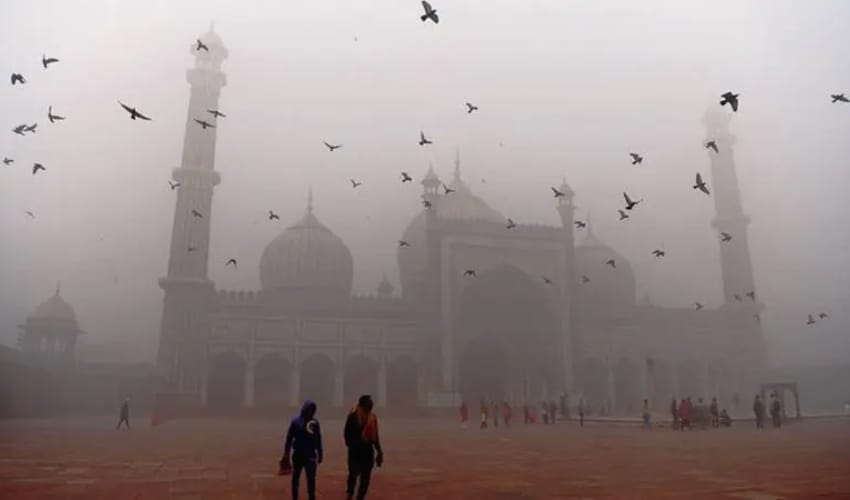By: Zara Amoon
The city of Lahore, Pakistan’s cultural and historical hub, is grappling with an escalating air pollution crisis driven largely by seasonal smoke, posing serious threats to public health and daily life. Each year, as industrial emissions, vehicle exhaust, agricultural fires, and seasonal weather combine, Lahore is blanketed by a thick layer of smog. The consequences are profound, impacting residents’ health, mobility, and quality of life.
Primary Sources of Pollution in Lahore:
Experts attribute Lahore’s worsening air quality to multiple factors, each amplifying the presence of pollutants in the atmosphere.
Industrial Emissions: The city’s dense industrial landscape emits high levels of carbon monoxide, sulfur dioxide, and nitrogen oxides. Factories in Lahore frequently operate on low-grade fuel and without modern pollution controls, significantly degrading air quality.
Vehicular Emissions: Lahore’s expanding vehicle population, particularly cars, motorbikes, and buses, adds substantial quantities of particulate matter (PM2.5 and PM10) to the air. Many of these vehicles rely on diesel and petrol, worsening air quality and endangering residents’ health.
Agricultural Burning: Seasonal crop burning in rural areas surrounding Lahore introduces a major source of fine particulates into the city’s air, particularly during winter months. This practice, while convenient for farmers, contributes to smoke that easily drifts into the urban landscape.
Weather Patterns and Geography: Lahore’s climate further complicates matters. During winter, stagnant air and temperature inversions trap pollutants close to the ground, intensifying the smog and making it difficult to dissipate.
Construction Dust: Rapid urban growth and constant construction projects add large amounts of dust to Lahore’s atmosphere, exacerbating already poor air conditions.
Impact on Public Health:
Medical experts warn that Lahore’s smog poses a direct threat to human health, particularly for vulnerable groups like children and the elderly.
Respiratory and Cardiovascular Problems: Particulate matter in smog penetrates deeply into the lungs, causing respiratory diseases like asthma and chronic obstructive pulmonary disease (COPD). Cardiologists also report a rise in heart attacks, strokes, and hypertension cases during peak smog periods, due to fine particles entering the bloodstream and causing vascular inflammation.
Weakened Immune Systems: Doctors caution that sustained exposure to airborne pollutants compromises immune function, making residents more susceptible to infections. Healthcare providers in Lahore report increased cases of respiratory infections during smog season.
Eye and Skin Irritation: Exposure to pollutants such as sulfur dioxide and nitrogen oxides irritates the eyes and skin, leading to burning sensations and skin problems for many residents.
Mental Health Concerns: Lahore’s poor air quality has taken a toll on residents’ mental health as well. Restricted outdoor activities and smog-related anxieties contribute to heightened levels of stress, anxiety, and depression among city dwellers.
Challenges in Daily Life and Economic Impact:
Beyond the physical health toll, smoke in Lahore disrupts everyday routines, hampers economic productivity, and increases healthcare costs.
Reduced Mobility: Thick smog reduces visibility, creating dangerous conditions for driving and causing accidents. Public schools and workplaces occasionally shut down during periods of severe pollution, impacting productivity and educational continuity.
Impact on Tourism and Economy: Lahore’s historic and cultural attractions, which typically draw many visitors, see a downturn in tourism during smog season. Health issues among residents also lead to higher absenteeism and reduced work efficiency, adding an economic strain.
Increased Healthcare Costs: Families in Lahore face significant medical expenses due to respiratory and cardiovascular conditions linked to pollution. This increase in healthcare demand puts added pressure on both private and public health resources.
Environmental Consequences of Smoke Pollution:
Environmentalists warn that the smoke crisis is not only affecting residents but is also taking a toll on local ecosystems and the climate.
Damage to Ecosystems: Pollutants in the air settle onto soil and water sources, affecting plant growth and animal habitats. Smog inhibits photosynthesis in plants, stunting crop growth and harming biodiversity.
Acid Rain: Industrial pollutants in Lahore’s air can contribute to acid rain, which harms both soil and water resources, affecting the health of aquatic life and agricultural productivity.
Climate Effects: Lahore’s reliance on fossil fuels exacerbates greenhouse gas emissions, contributing to global warming. This worsens the cycle of pollution and weather changes, heightening the risk of future severe smog episodes.
Potential Solutions and Next Steps:
Experts emphasize that addressing Lahore’s air quality crisis will require decisive action at both the policy and community levels.
Improving Public Transportation: Expanding Lahore’s public transportation system to reduce reliance on private vehicles could significantly lower emissions. Metro expansion, clean buses, and carpool incentives are seen as crucial steps.
Stricter Emission Standards: Implementing higher emission standards for industries and vehicles could curb pollutant levels. Cleaner fuels, such as compressed natural gas (CNG) or electric options, offer promising alternatives.
Reducing Agricultural Burning: Authorities can promote sustainable alternatives to crop burning, such as mechanical plowing or converting crop residues to bioenergy, to decrease smoke emissions.
Raising Public Awareness: Educating Lahore’s residents about the risks of pollution and encouraging protective measures, such as limiting outdoor activities and wearing masks during high-pollution periods, could help reduce health impacts.
Expanding Green Spaces: Urban green spaces, such as parks and tree plantations, can help purify air and mitigate the urban heat island effect, providing a natural buffer against pollution.
Lahore’s smoke and air pollution crisis is a critical issue affecting public health, quality of life, and the environment. While the problem is complex, a combination of regulatory action, technological solutions, and public involvement offers a path toward cleaner air. Addressing the root causes of Lahore’s pollution crisis will require collective action, but t inhe benefits—improved health, sustainable urban living, and a safer environment—are well worth the effort.


